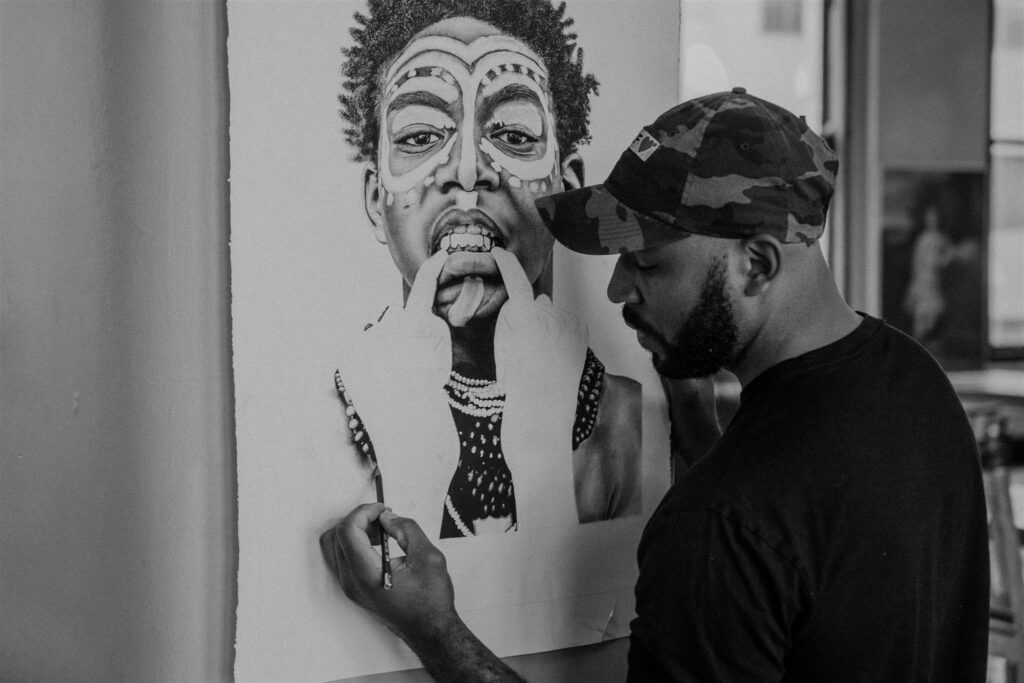Q&A with Cincinnati-based Visual Artist Gee Horton
Posted on October 17, 2023
Gee Horton is a Cincinnati-based visual artist who explores the complexities of the human form in his art. FotoFocus interviewed Horton to learn more about his participation in The Convening, his art practice, and what’s coming next.
Cincinnati-based visual artist Gee Horton, a recipient of ArtsWave’s Truth and Reconciliation grant, pioneered The Baobab Project, an ongoing collaboration designed to provide a platform for Black men to explore their vulnerability while reflecting on their coming-of-age experiences. Horton has garnered recognition through his involvement in HBO’s Insecure and Amazon Prime’s Harlem, and has received an Emmy in short-form content for his participation in an artist-residency at The Mercantile Library of Cincinnati, which resulted in a six-foot portrait honoring renowned Black abolitionist and writer, Peter H. Clark. Horton completed a 2022 artist residency with DiasporicSoul in Senegal, and was named a 2023 40 Under 40 awardee by the Cincinnati Business Courier.
FotoFocus chatted with Horton to learn more about his participation in The Convening and what’s coming next.
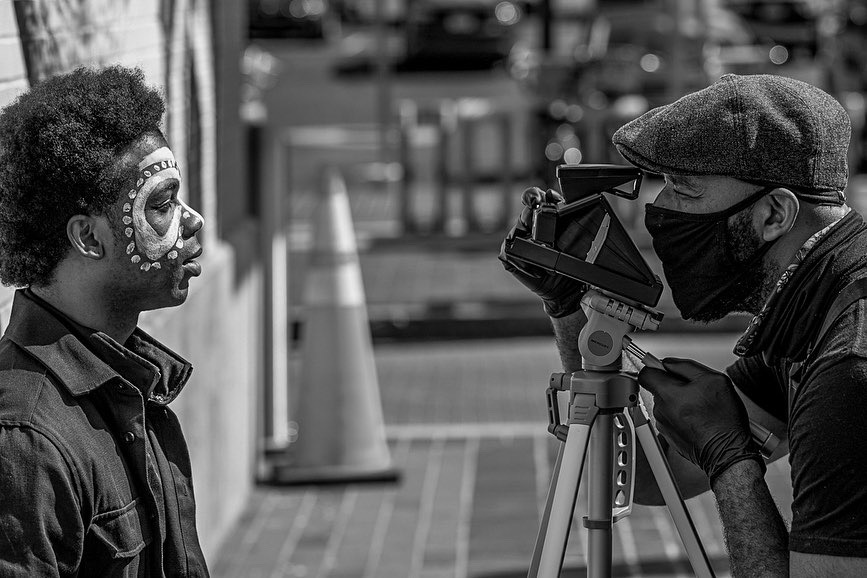
FotoFocus: As we promote your participation, how does your personal work and philosophy relate to the themes of The Convening?
Gee Horton: Absolutely, the theme of trees from The Convening deeply resonates with me and my personal work, particularly within the context of the Baobab Project. This project employs a multi-faceted approach, incorporating photography, collage, and mixed media to delve into the nuanced experiences of Black men as they come of age. It is conceptually grounded and finds its roots in the majestic baobab trees native to Africa. These baobab trees are considered sacred, serving as ritual and communal spaces where ceremonies take place.
Within The Baobab Project, I draw meaningful parallels to the modern-day Barbershop, which serves as a contemporary representation of the sacred baobab tree and is also the physical space where the Baobab Project is housed. Through the act of convening in the barbershop, my intention was to create a space where men could tap into a profound source of empowerment, liberation, agency, and the capacity to embrace emotions such as joy, delight, wonder, and vulnerability. The tree, in its grandeur, stands as a symbol greater than myself—an embodiment of the divine, an unseen force that we can feel. It serves as a constant reminder of my own smallness and the enduring presence of that inner child within me, which can continue to thrive throughout my lifetime.
In my recent journey to Senegal, I found myself immersed in the depths of the forest, surrounded by colossal trees. These ancient sentinels instilled in me a profound sense of wonder, but they also forged a connection to my inner power, agency, and liberation. These experiences have left an indelible mark on my artistic work. Even if the full scope of my creations remains unseen, the essence of that curiosity, wonder, delight, and empowerment is woven into every piece of my art.
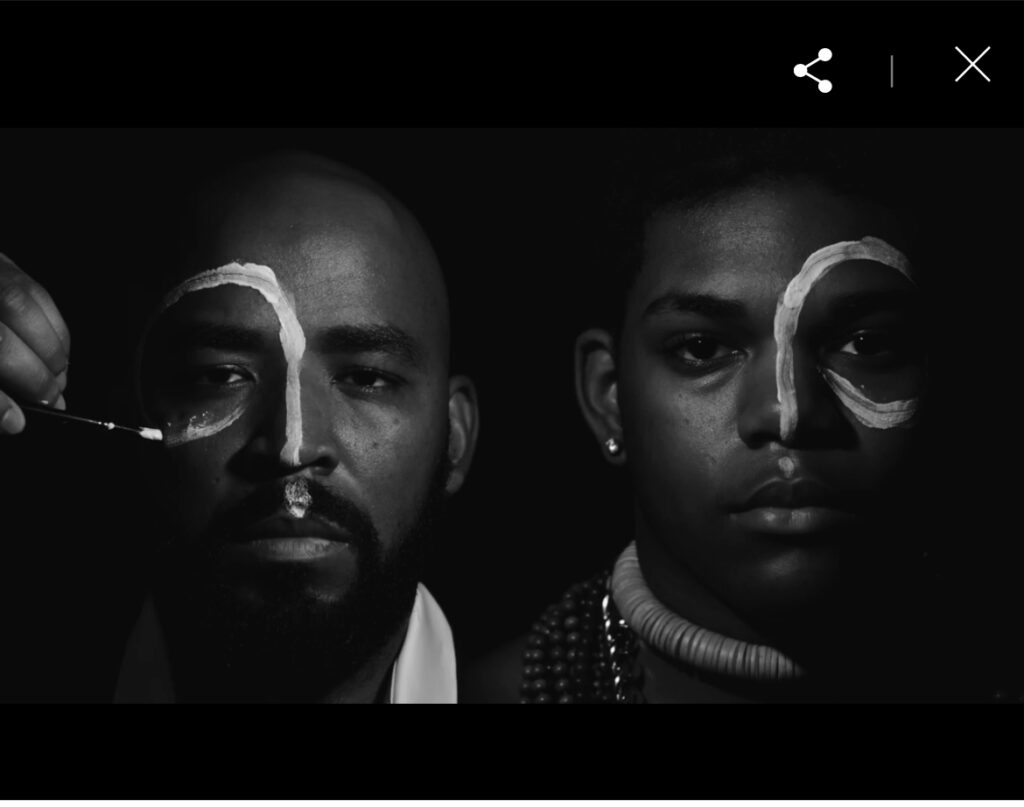
FF: Do you consider this land, this place, this region in your bodies or work and how? How does place play into that?
GH: I’m often regarded as a transplant in Cincinnati, but this city has truly become my home. It significantly shaped my identity as an artist and my role in the creative community. I have a profound love and appreciation for this place. However, I’m originally from Louisville, Kentucky, a city historically associated with the American South but geographically connected to this region due to its proximity to the Midwest. Like Cincinnati, Louisville is marked by the Ohio River, which serves as both an invisible boundary and a gateway, dividing the North from the South. I find this duality rather interesting as I explore how both these places show in my work.
As a black man who grew up in Louisville and now resides in Cincinnati as both an adult and an artist, my work is deeply rooted in the experiences of healing and reconciliation. These experiences are closely tied to the wounds of my upbringing in the American South, where the lasting impact of white supremacy, racism, and poverty has significantly shaped my journey and creative expression.
This influence is particularly evident in my recent Coming of Age: Chapter One series, which premiered at the Alice F. & Harris K. Weston Art Gallery in 2021. This series serves as a conceptual exploration, aiming to celebrate and affirm the innate innocence and vulnerability of Black youth, as seen through the eyes of my 14-year-old nephew in Louisville, Kentucky. It also acts as a form of self-reflection, allowing me to confront my own past experiences and embark on a healing process. Furthermore, this series provides viewers with a direct glimpse into how the environment and surroundings have influenced my artistic work.
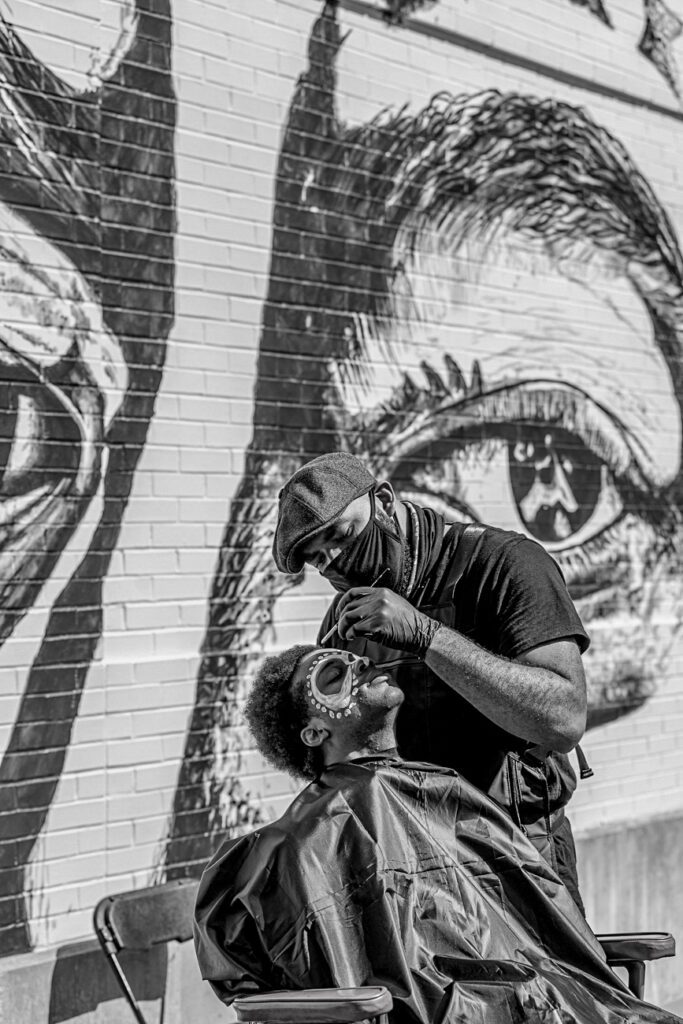
FF: What is coming next for you? How can we support your endeavors?
GH: I’ve recently relocated to a new studio space in Over-the-Rhine. This new studio presents an opportunity for me to pursue two significant endeavors. Firstly, I’ll be delving into printmaking, both of my own work and that of fellow creatives, which is an exciting addition to my artistic practice. Secondly, I am thrilled to announce my collaboration with the Kennedy Heights Cultural Arts Center in 2024 for my ongoing series, “The Baobab Project.” This project employs a photo-based, collage, and mixed-media approach to delve into the nuanced journey of Black men coming of age.
I’m currently engrossed in crafting a new body of work, which draws its inspiration from my recent pilgrimage to Senegal, West Africa. This collection will encompass various artistic mediums, such as drawings, poems, collages, photography, videos, and journal reflections. These pieces will vividly capture my deep connection with the people of the Jola and Mandinka ethnic groups, particularly during my time in Senegal, especially in the southern region of Casamance.
It was within this period that I embarked on a profoundly personal journey of self-discovery and coming of age, under the guidance of remarkable individuals. This transformative experience now serves as a boundless source of inspiration for my artistic pursuits. Through my art, I aim to portray the community that played a pivotal role in nurturing and guiding my coming-of-age experience in Senegal, West Africa. This journey was a profound catalyst for healing, prompting me to re explore some of the same questions that have previously ignited my creative work.
Finally, I hope my artworks get selected for the 2024 FotoFocus Biennial. If they make the cut, they’ll be exhibited in partnership with the Kennedy Heights Cultural Arts Center, alongside Phyllis Jeffers Coly’s and Phillip Hamilton’s Peace of Mind Project.
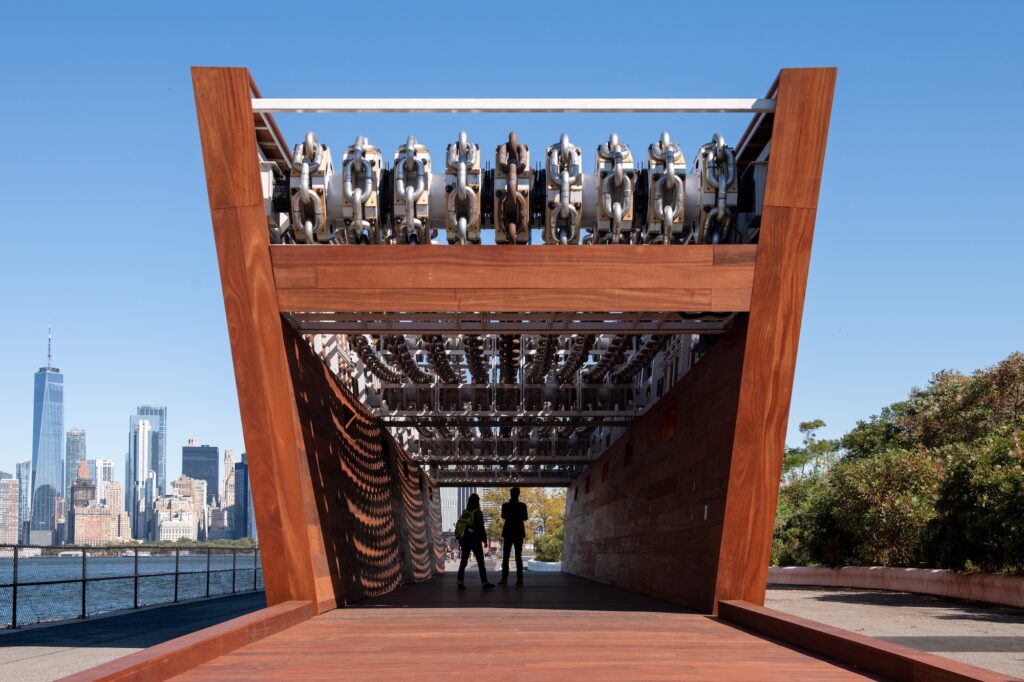
FF: Whose work do you look at, in terms of the themes of The Convening, as a resource or that you admire who we may not know about?
GH: In the realm of conceptual art, figures like Charles Gaines undeniably exert a profound influence on my work. However, my artistic journey took a unique path, as I didn’t attend art school or major in art history. Instead, I’ve found myself drawn to artists within the music world, particularly in genres like hip-hop and jazz, which have had a profound impact on my creative expression. While I continually seek inspiration from contemporary artists like Leonardo Drew, Nick Cave, and Kerry James Marshall, none resonate with me as deeply as listening to Kendrick Lamar, Tupac Shakur, Mos Def, or the late jazz saxophonist Pharoah Sanders.
The world of 1990s hip-hop stands out as a space where black men have consistently found their voices. It’s a realm where our voices have not been silenced, but rather have thrived. For my generation, it has been a source of freedom, liberation, and a platform for expressing resistance. Therefore, I often gravitate towards it as a wellspring of inspiration.
Horton will participate in the 10am panel at the National Underground Railroad Freedom Center on Saturday, October 21, 2023 with Charles Gaines, Artist, Los Angeles, CA; Moderated by Justine Ludwig, Executive Director, Creative Time, New York, NY.
Check out the full Symposium schedule.
